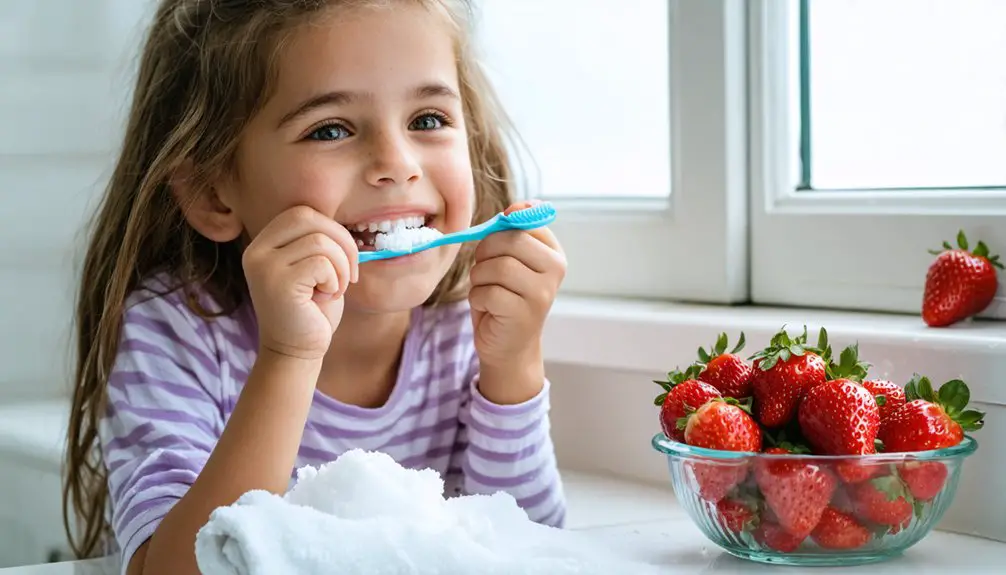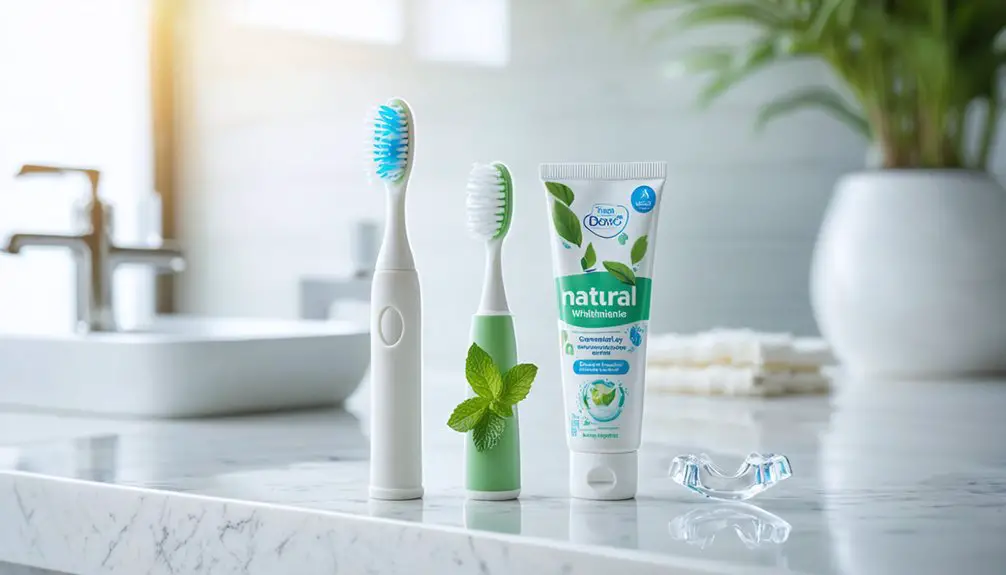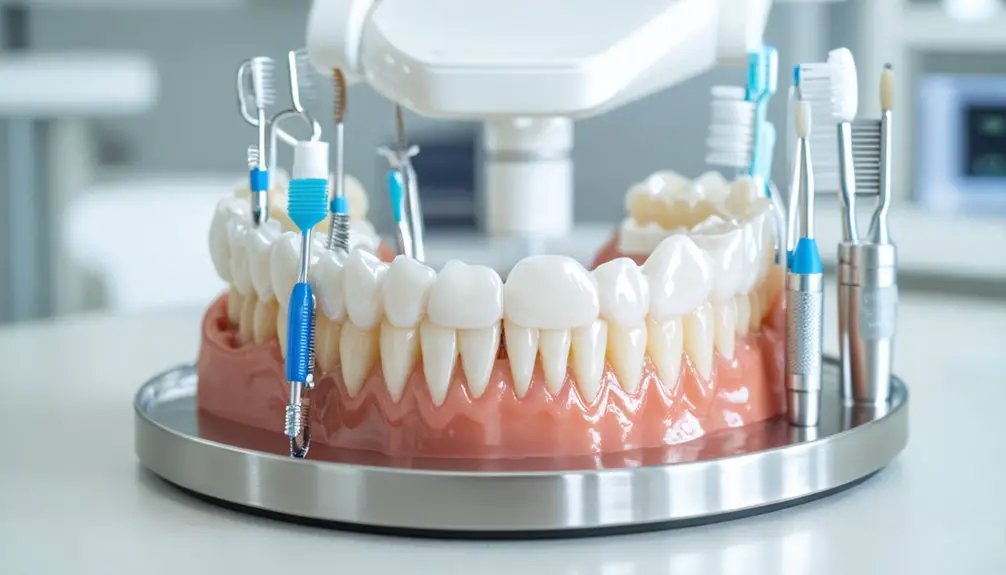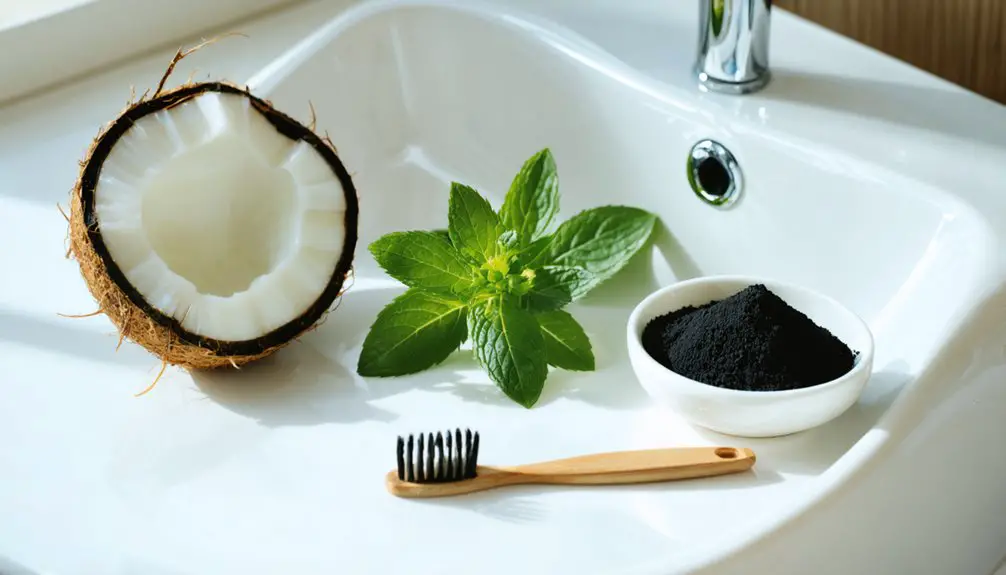When it comes to whitening your child’s teeth, you’ll want to follow three key precautions for the safest results. First, wait until their permanent teeth are fully developed, typically around age 12, to prevent uneven results. Second, always choose professional dental supervision over DIY treatments to protect developing enamel. Third, start with gentle, natural methods like crunchy fruits and vegetables before considering chemical treatments. These smart steps will guide you toward achieving that brighter smile safely.
Key Takeaways
- Wait until permanent teeth are fully developed around age 12 before considering any whitening treatments.
- Always seek professional dental supervision rather than using DIY whitening methods on children’s teeth.
- Start with natural whitening methods like crunchy fruits and vegetables before considering chemical treatments.
- Maintain consistent daily oral hygiene with fluoride toothpaste and soft-bristled brushes for natural brightness.
- Monitor treatment progress regularly and adjust plans based on dental examinations to prevent damage to developing teeth.
Wait for Full Dental Development Before Starting
While it may be tempting to whiten your child’s teeth at the first sign of discoloration, it’s crucial to wait until their permanent teeth have fully developed. The age recommendations from dental health experts suggest waiting until at least age 12, when most permanent teeth have emerged.
Your child’s teeth undergo significant changes between ages 6 and 13. During this time, they’ll lose their baby teeth and gain permanent ones in a specific order. The exfoliation stages progress systematically from the front teeth to the back molars. Most children have twenty primary teeth that must fall out before permanent teeth can fully emerge.
The mixed dentition stage, where both baby and permanent teeth are present, makes whitening treatments risky and potentially uneven. By waiting until after age 12, you’ll make sure your child’s tooth enamel is strong enough to handle whitening agents safely, and you’ll avoid complications that could arise from treating developing teeth.
Choose Professional Supervision Over DIY Solutions
Once your child reaches the right age for teeth whitening, seeking professional dental supervision is far safer than attempting DIY treatments at home.
A dentist will establish proper safety protocols, including protective barriers for gums and careful monitoring of your child’s comfort throughout the process.
Your dentist’s treatment customization guarantees the perfect balance of whitening agents for your child’s specific needs.
They’ll examine existing stains, consider any orthodontic appliances, and create a tailored plan that avoids damage to developing teeth.
Since teens under 14 have developing tooth enamel, professional monitoring is essential to prevent sensitivity and damage.
Professional supervision also prevents common DIY mistakes like overuse of whitening products or incorrect application methods.
You’ll see better, faster results under professional care, and your child will learn valuable oral hygiene habits that help maintain their brighter smile long-term.
The process delivers immediate results after just one professional session, making it easier to track progress and adjust treatment if needed.
Start With Natural and Gentle Whitening Methods

Before turning to chemical treatments, you’ll want to explore gentle, natural methods to brighten your child’s smile.
Start with natural remedies like encouraging your child to eat crunchy fruits and vegetables, which naturally scrub teeth while providing essential nutrients. Apples, carrots, and celery work as nature’s toothbrushes.
Crunchy fruits and vegetables act as natural tooth cleaners while nourishing your child’s body – nature’s perfect solution for dental care.
Consider gentle techniques such as mixing a small amount of baking soda with regular toothpaste once weekly. You can also try mashed strawberries as a mild whitening agent, but limit use to once per week. Adding dairy products to meals helps strengthen tooth enamel for a brighter smile.
Remember to maintain consistent brushing with fluoride toothpaste twice daily using a soft-bristled brush, and don’t forget daily flossing. Using a straw for staining beverages can significantly reduce the risk of discoloration on your child’s teeth.
These habits, combined with reducing sugary and acidic foods, will help preserve your child’s natural tooth brightness while protecting their dental health.
Frequently Asked Questions
How Often Should Children Have Their Teeth Professionally Cleaned Before Whitening Treatments?
Like clockwork, you’ll need professional cleanings every 6 months to protect your child’s dental health. Don’t skip these crucial appointments before considering whitening treatments – they’re essential for safe, effective results.
What Specific Foods and Drinks Are Most Likely to Stain Children’s Teeth?
Your child’s teeth are most vulnerable to staining beverages like dark sodas, sports drinks, and tea, plus acidic foods like tomato sauce and berries that can weaken enamel.
Can Medications or Medical Conditions Affect the Success of Teeth Whitening?
Yes, medication impacts and medical conditions can affect your whitening results. Some medicines stain teeth from the inside, while health conditions can change how your teeth respond to whitening treatments.
Are There Different Whitening Recommendations for Children With Dental Crowns or Fillings?
You’ll need special care for crown and filling safety during whitening, as these materials won’t whiten like natural teeth. Always consult your dentist for personalized guidance on treatment options.
What Signs Indicate a Child Is Experiencing Adverse Reactions to Whitening Products?
Watch for tooth sensitivity symptoms like pain with hot/cold foods, swollen or red gums, uneven tooth color, and signs of allergic reactions including unusual swelling or stomach discomfort.
References
- https://www.kidsdentalonline.com/dental-topics/teeth-whitening-safe-children/
- https://cashmerefamilydentistry.com/why-you-shouldnt-whiten-your-childrens-teeth/
- https://www.dentistjustforkids.com/is-it-safe-to-whiten-your-childrens-teeth/
- https://www.aapd.org/globalassets/media/publications/archives/lee-27-5.pdf
- https://www.dentistryjust4kids.com/blog/is-it-ok-for-kids-to-whiten-their-teeth/
- https://ballantynepedo.com/how-many-baby-teeth-do-kids-lose-timeline-stages-explained/
- https://www.lancasterpediatricdentistry.com/tooth-development-cycle-for-children/
- https://www.betterhealth.vic.gov.au/health/conditionsandtreatments/teeth-development-in-children
- https://www.deltadental.com/us/en/protect-my-smile/life-stages/infants-toddlers/timeline-for-teeth.html
- https://dentistryforkids.info/blog/2019/07/development-care-of-childrens-teeth-a-timeline/



